
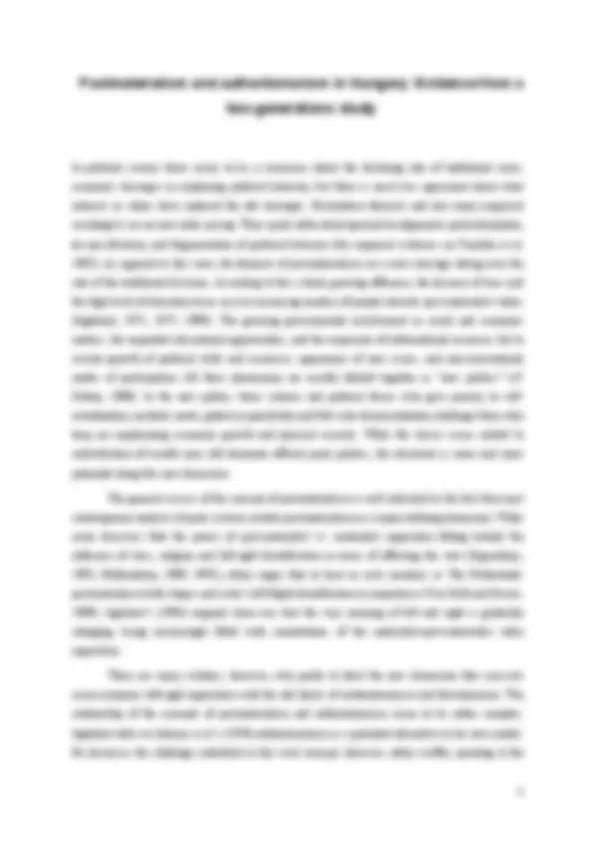
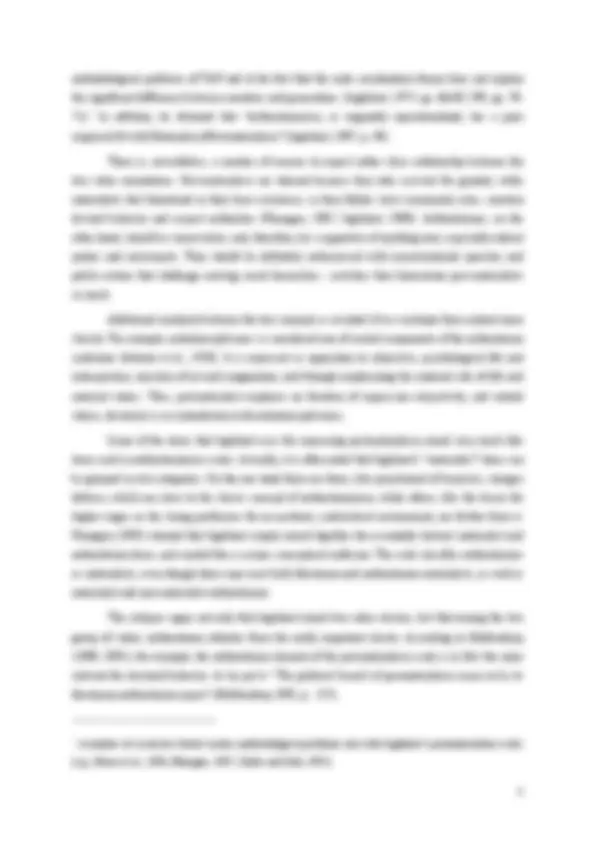
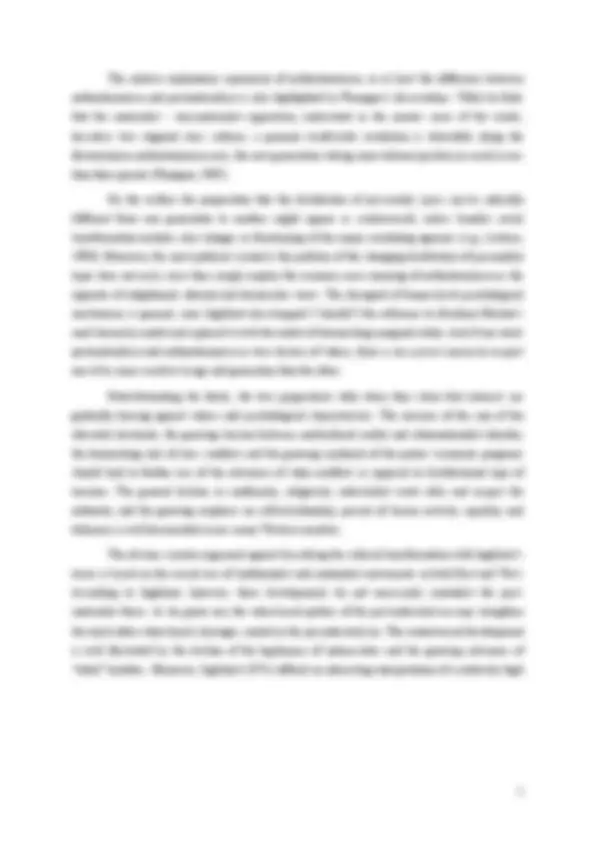
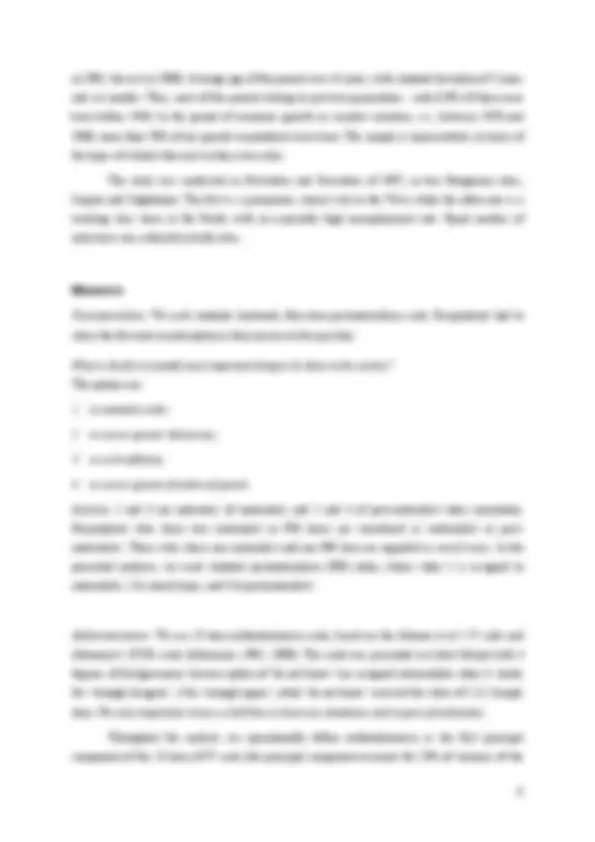
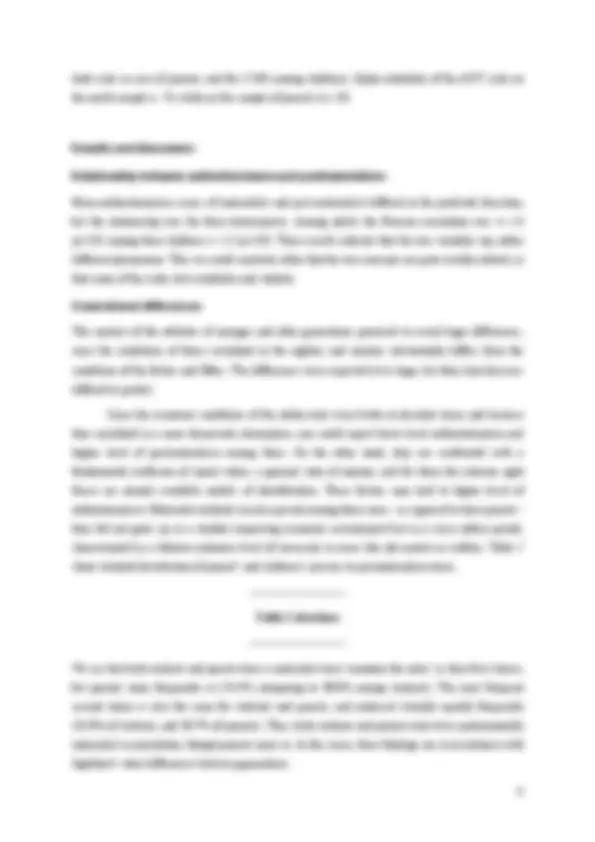
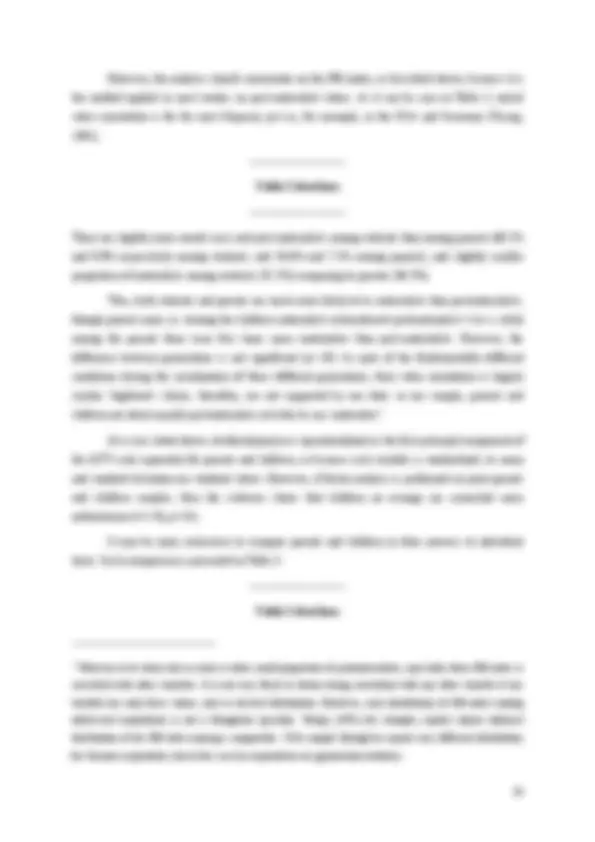
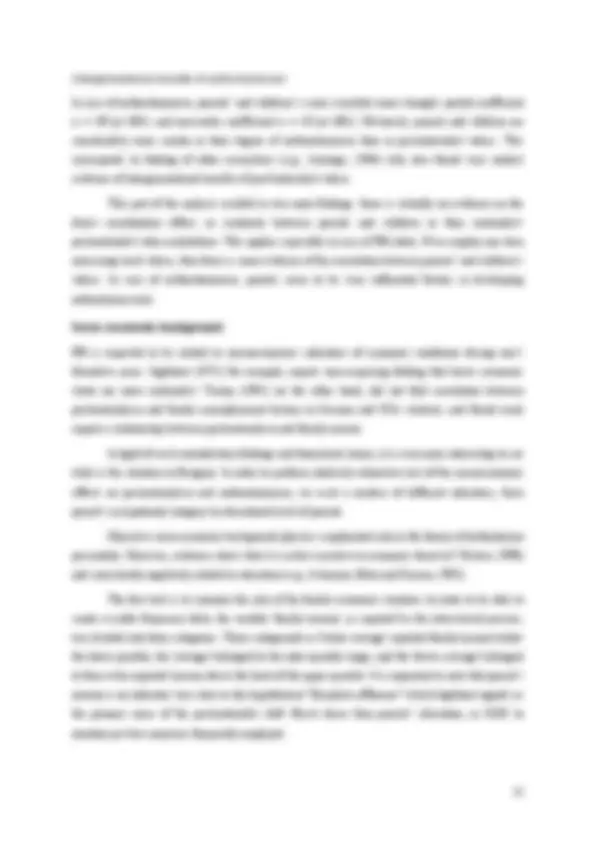
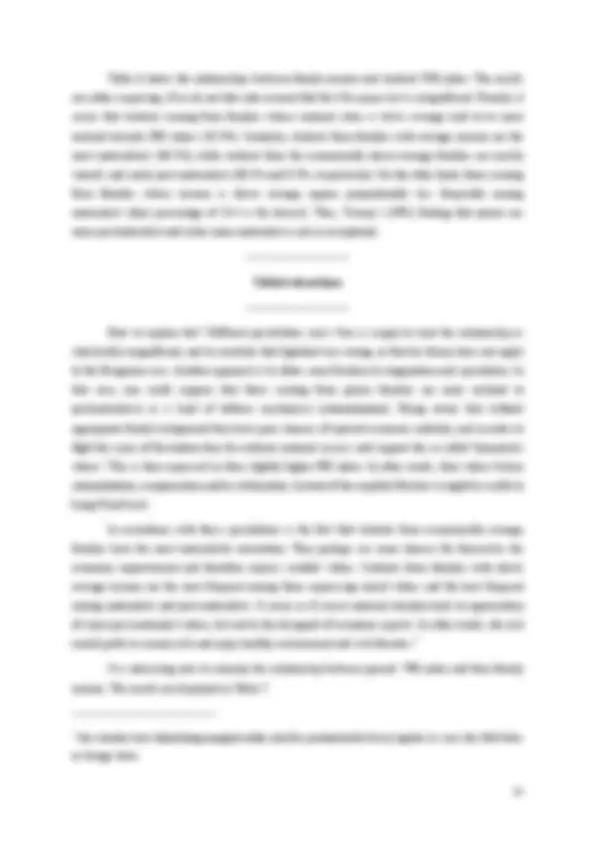
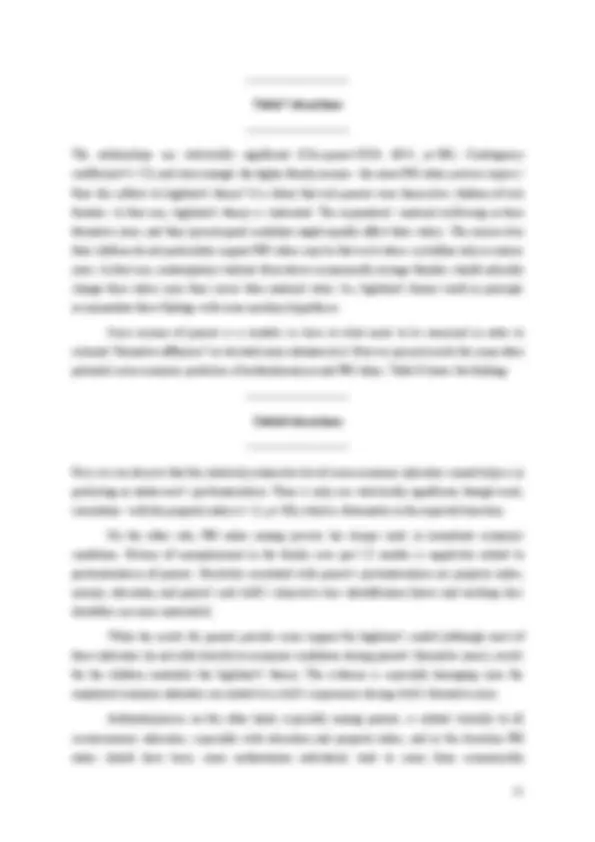
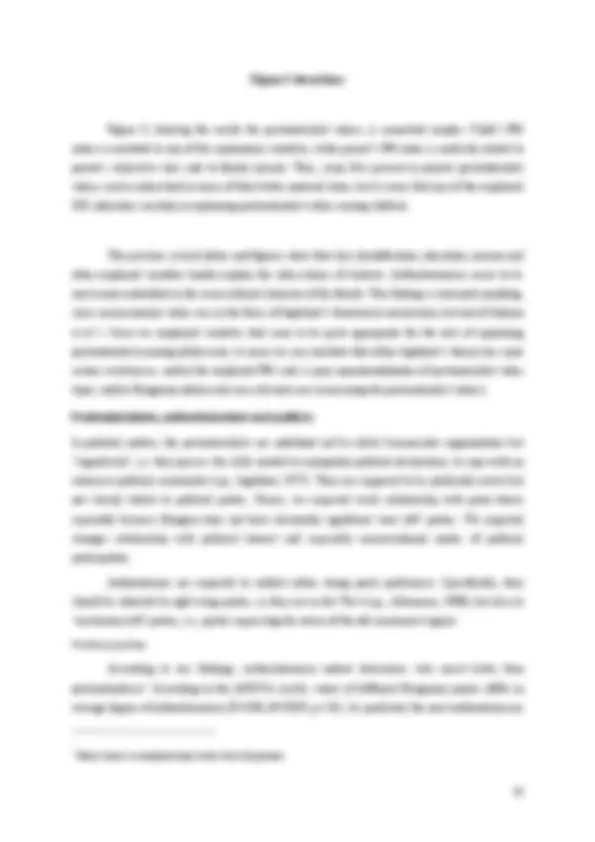
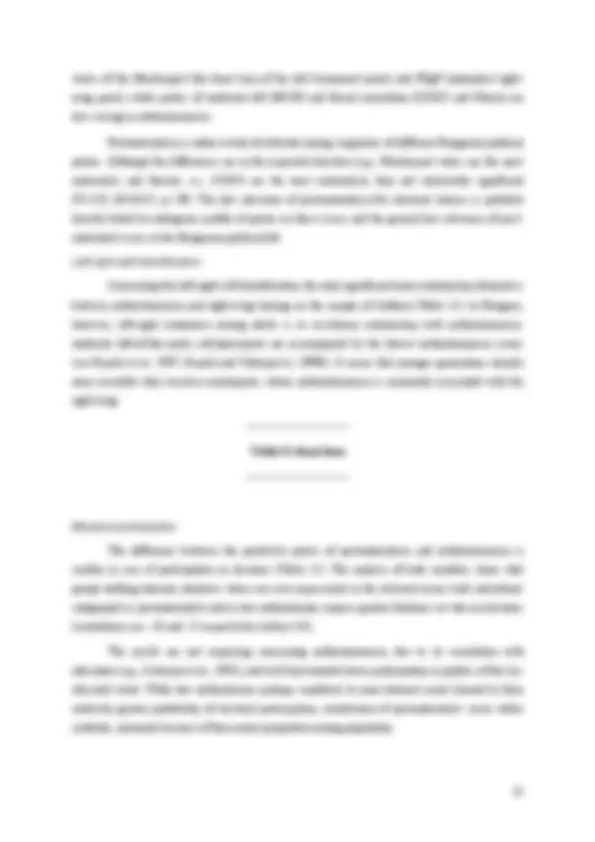
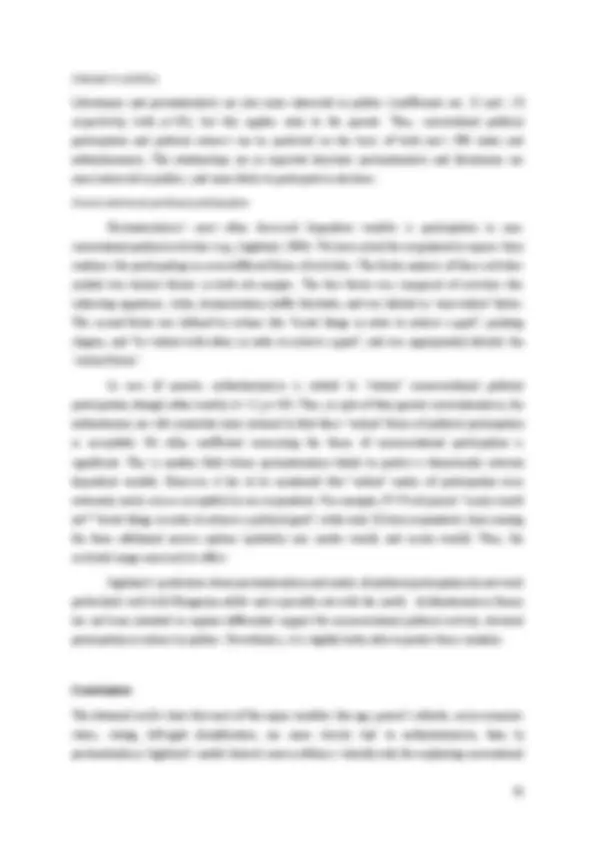
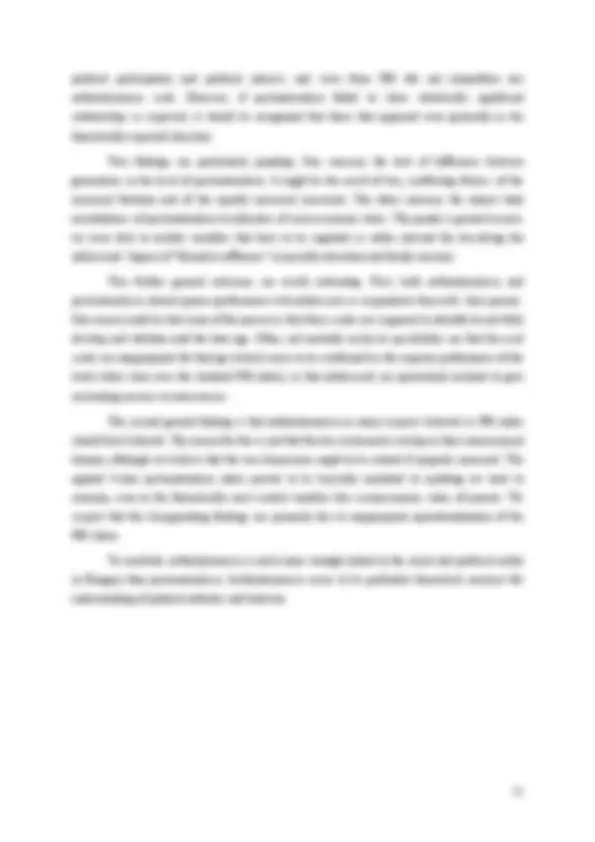
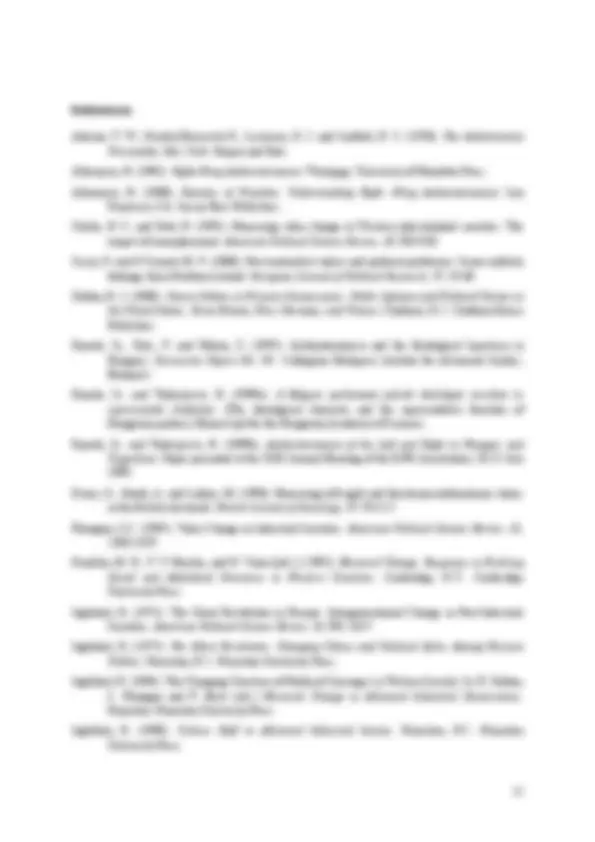
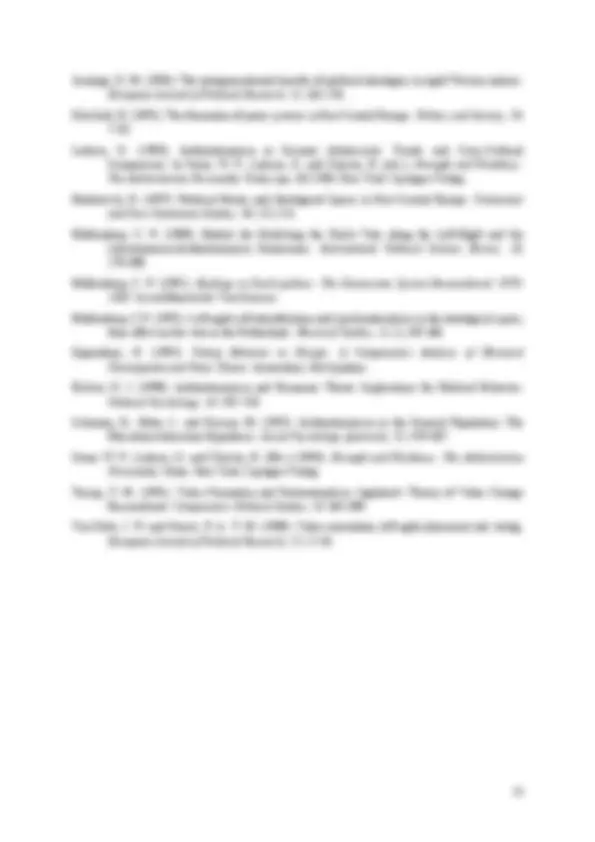


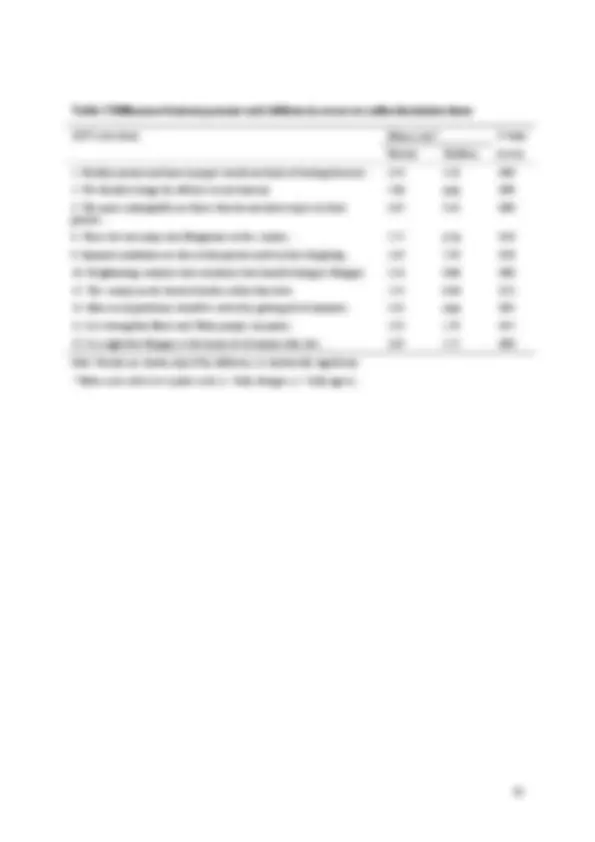
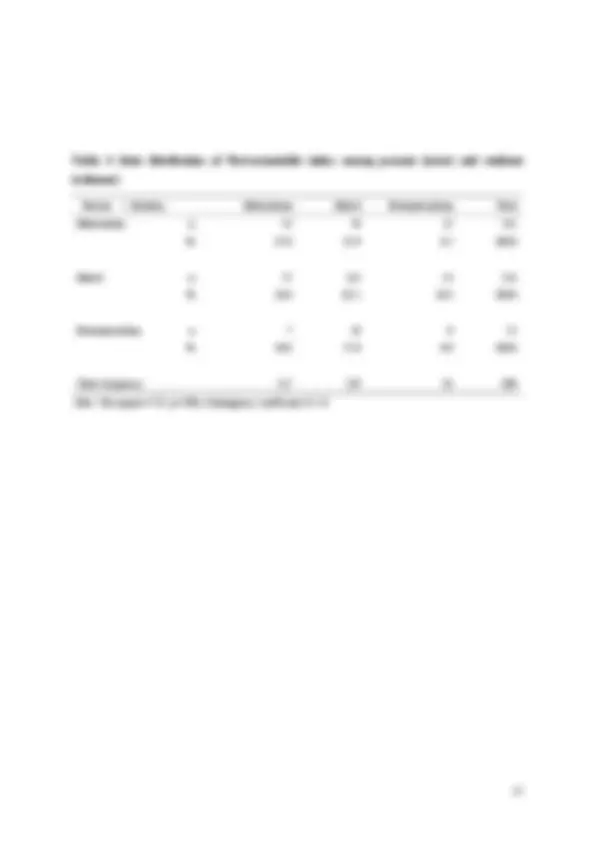
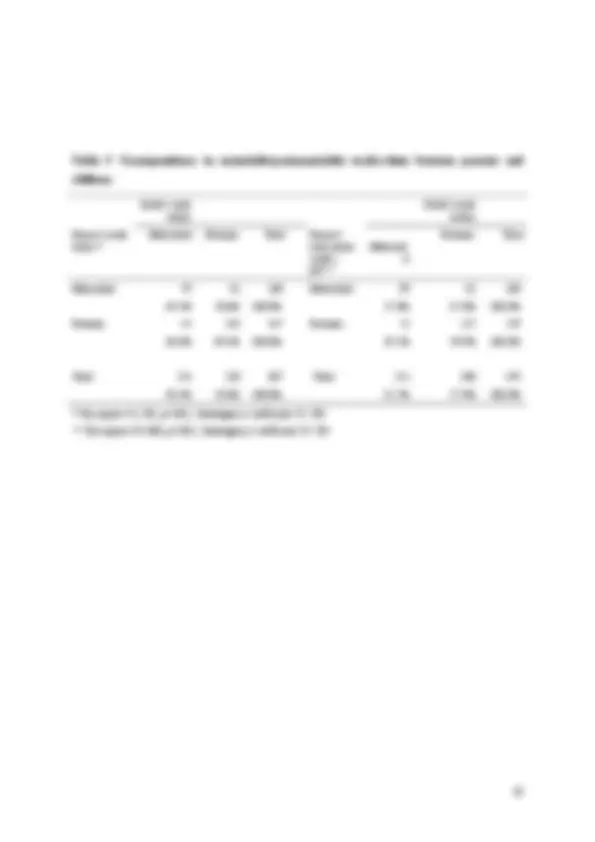
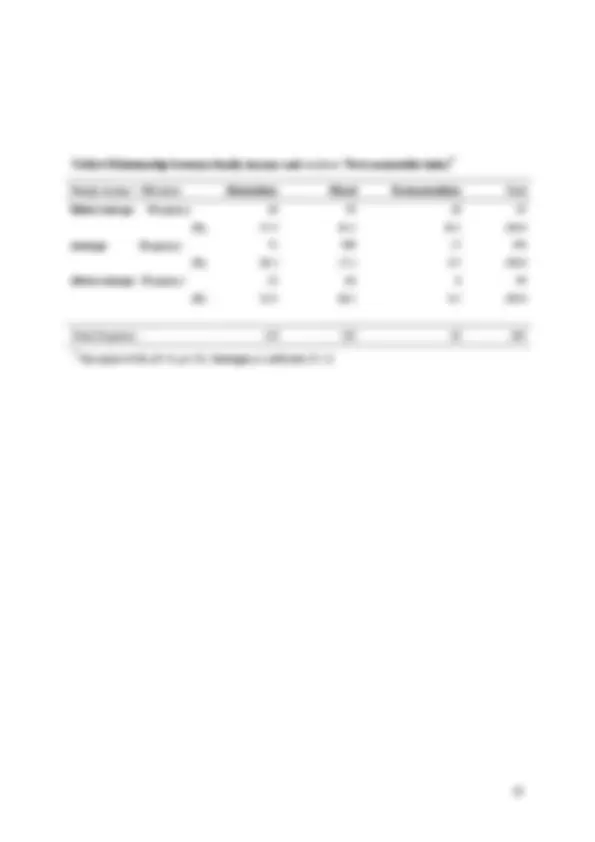

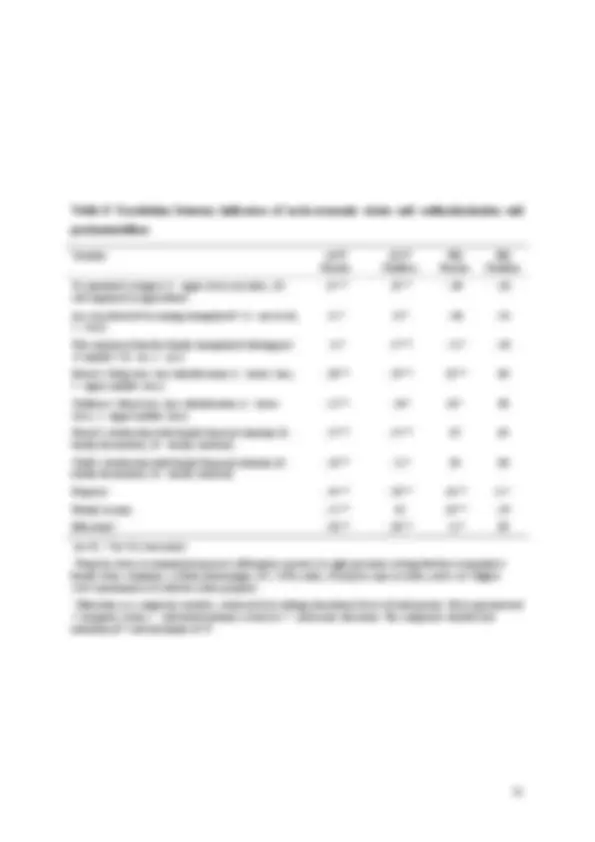
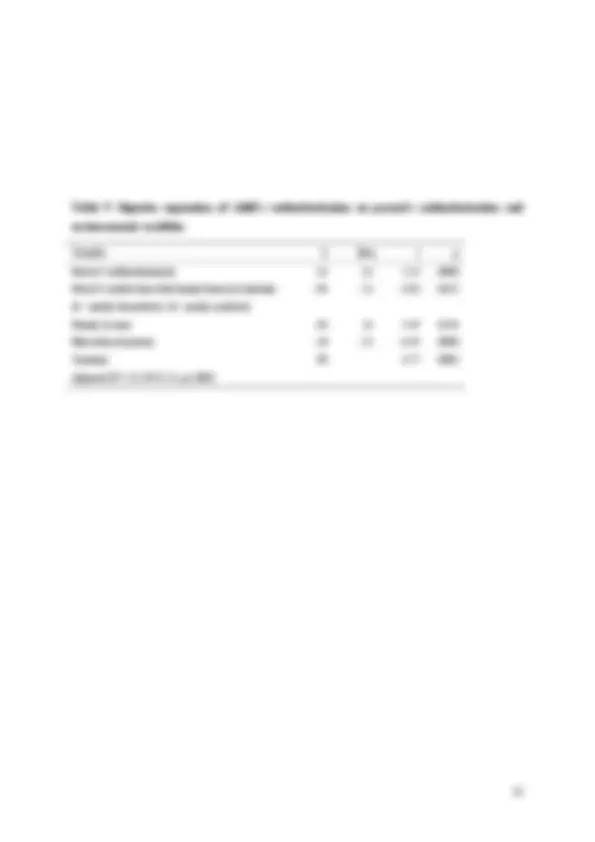
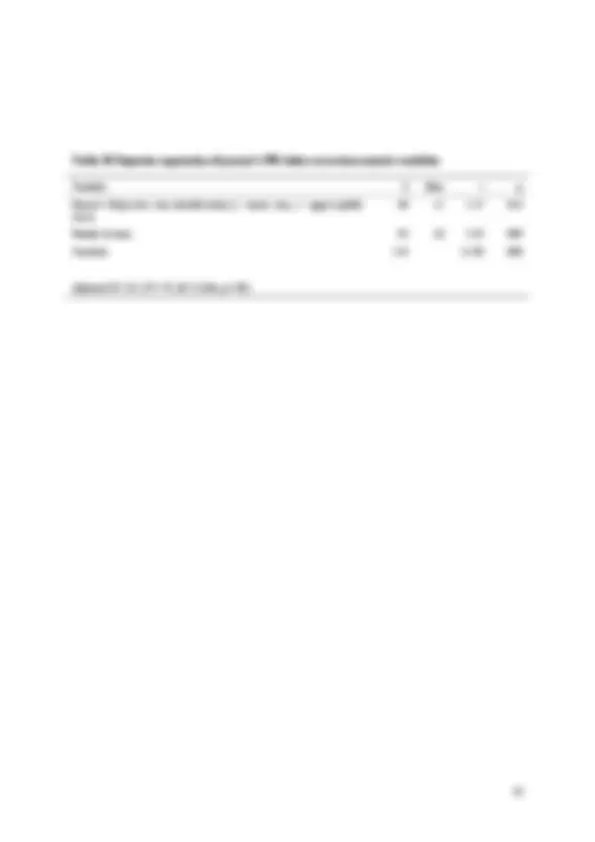
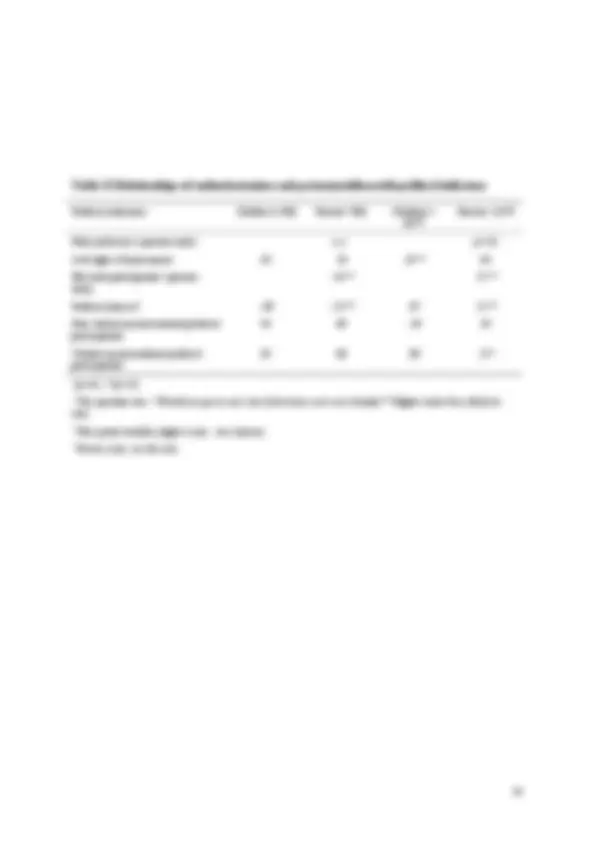


Study with the several resources on Docsity

Earn points by helping other students or get them with a premium plan


Prepare for your exams
Study with the several resources on Docsity

Earn points to download
Earn points by helping other students or get them with a premium plan
Community
Ask the community for help and clear up your study doubts
Discover the best universities in your country according to Docsity users
Free resources
Download our free guides on studying techniques, anxiety management strategies, and thesis advice from Docsity tutors
The differences between authoritarianism and postmaterialism values in parents and children through an analysis of their answers to various items. The study uses the Authoritarianism Scale (AUT) and Inglehart's Postmaterialism Index (PM) to examine the transmission of values within families and their relationship with socio-economic indicators.
What you will learn
Typology: Exercises
1 / 34

This page cannot be seen from the preview
Don't miss anything!



























by
Bojan Todosijević (address and eMail for correspondence)
Zsolt Enyedi
Political Science Department Central European University Political Science Department Nador u. 9 Central European University 1051 Budapest, Hungary
Running title: Postmaterialism and authoritarianism in Hungary
Society for Political Psychology, Seattle, June 29 - July 4 2000.
Postmaterialism and authoritarianism in Hungary: Evidence from a two-generations study
Abstract
The paper compares the concepts of post-materialism and authoritarianism in terms of their relationships with theoretically relevant dependent and independent variables. The research is based on a survey of a random sample of 400 adolescent children and the same number of their parents from two Hungarian cities. The results indicate that the two concepts are largely unrelated in Hungary. While the youth proved to be somewhat more authoritarian than the parents, there are no intergenerational differences in postmaterialism score. Socialization and family status have a stronger impact on authoritarianism than on post-materialism. The affluence of parents does not make their children more post-materialist, even though it makes their own values skewed somewhat towards post-materialism. Authoritarianism is more closely related to various indicators of political behavior and preferences. Most expectations based on the postmaterialist hypothesis were not confirmed. Authoritarianism seems to be more useful concept for political research, at least in the post-Communist context.
methodological problems of TAP and at the fact that the early socialization theory does not explain the significant difference between countries and generations. (Inglehart, 1977, pp. 66-69; 199, pp. 70- 71). 1 In addition, he obtained that “authoritarianism, as originally operationalized, has a poor empirical fit with Materialism/Postmaterialism” (Inglehart, 1997, p. 48).
There is, nevertheless, a number of reasons to expect rather close relationship between the two value orientations. Post-materialists are tolerant because they take survival for granted, while materialists feel threatened in their basic existence, so they follow strict community rules, sanction deviant behavior and respect authorities (Flanagan, 1987, Inglehart, 1990). Authoritarians, on the other hand, should be conservative, and, therefore, less supportive of anything new, especially radical parties and movements. They should be definitely embarrassed with unconventional speeches and public actions that challenge existing social hierarchies - activities that characterize post-materialists so much.
Additional similarity between the two concepts is revealed if we scrutinize their content more closely. For example, antiintraceptiveness is considered one of central components of the authoritarian syndrome (Adorno et al., 1950). It is expressed as opposition to subjective, psychological life and introspection, rejection of art and imagination, and through emphasizing the material side of life and material values. Thus, postmaterialist emphasis on freedom of expression subjectivity, and related values, obviously is in contradiction with antiintraceptiveness.
Some of the items that Inglehart uses for measuring postmaterialism sound very much like items used in authoritarianism scales. Actually, it is often noted that Inglehart's “materialist” items can be grouped in two categories. On the one hand there are those, like punishment of terrorists, stronger defense, which are close to the classic concept of authoritarianism, while others, like the desire for higher wages or the strong preference for an aesthetic, undisturbed environment, are further from it. Flanagan (1987) claimed that Inglehart simply mixed together the essentially distinct materialist and authoritarian items, and created thus a serious conceptual confusion. The scale classifies authoritarians as materialists, even though there may exist both libertarian and authoritarian materialists, as well as materialist and non-materialist authoritarians.
The critiques argue not only that Inglehart mixed two value clusters, but that among the two group of values authoritarian attitudes form the really important cluster. According to Middendorp (1989, 1992), for example, the authoritarian element of the postmaterialism scale is in fact the more relevant for electoral behavior. As he put it: "The political 'kernel' of postmaterialism seems to be its libertarian authoritarian aspect" (Middendorp 1992, p. 257).
(^1) A number of researches found serious methodological problems also with Inglehart’s postmaterialism scales
(e.g., Evans et al., 1986, Flanagan, 1987, Clarke and Dutt, 1991).
The relative explanatory superiority of authoritarianism, or at least the difference between authoritarianism and postmaterialism is also highlighted by Flanagan’s observations. While he finds that the materialist - non-materialist opposition, understood in the narrow sense of the words, describes two stagnant class cultures, a genuine world-wide revolution is detectable along the libertarianism-authoritarianism axis, the new generations taking more tolerant position in social issues than their parents (Flanagan, 1987).
On the surface the proposition that the distribution of personality types can be radically different from one generation to another might appear as controversial, unless broader social transformation includes also changes in functioning of the major socializing agencies (e.g., Lederer, 1993). Moreover, for most political scientists the problem of the changing distribution of personality types does not exist, since they simply employ the common sense meaning of authoritarianism as the opposite of enlightened, tolerant and democratic views. The disregard of deeper-level psychological mechanisms is general, since Inglehart also dropped (“silently”) the reference to Abraham Maslow's need hierarchy model and replaced it with the model of diminishing marginal utility. And if one treats postmaterialism and authoritarianism as two clusters of values, there is no a priori reason to suspect one to be more sensitive to age and generation than the other.
Notwithstanding the labels, the two propositions tally when they claim that interests are gradually loosing against values and psychological characteristics. The increase of the size of the educated electorate, the growing tension between multicultural reality and ethnonationalist identity, the diminishing role of class conflicts and the growing similarity of the parties' economic programs should lead to further rise of the relevance of value-conflicts as opposed to distributional type of tensions. The general decline in conformity, religiosity, industrialist work ethic and respect for authority, and the growing emphasis on self-actualization, pursuit of leisure activity, equality, and tolerance is well documented across many Western countries.
The obvious counter-argument against describing the cultural transformation with Inglehart’s terms is based on the recent rise of traditionalist and nationalist movements in both East and West. According to Inglehart, however, these developments do not necessarily contradict the post- materialist thesis. As he points out, the value-based politics of the post-industrial era may strengthen the much older value-based cleavages, rooted in the pre-industrial era. The controversial development is well illustrated by the decline of the legitimacy of nation-states and the growing relevance of “tribal” loyalties. Moreover, Inglehart (1971) offered an interesting interpretation of a relatively high
The following analysis will be conducted on a data-set coming from a post-Communist country, Hungary. This regional-political status of the country must have important implications for the detected relationships.
Shall we expect a politically relevant post-materialist dimension in the post-Communist world? The Eastern European societies could be fertile ground for post-materialist initiatives. Suffice it to point at the monumental ecological problems, electoral fluidity, weakness of traditional social bounds, relevance of values in political behavior, lack of agreement concerning traditional religious social and sexual norms, increasing portion of labor force working in tertiary sector, relatively well educated citizenry, etc. The ideological “baggage” of Easterners could also help. True, the official ideology of Communism was called “scientific materialism”, but it had in fact an extremely idealistic and utopian character, preaching the subordination of the individuals’ material needs to higher social goals.
Yet, post-materialist issues like nuclear energy, sexual equality or disarmament, do not feature prominently in the political battles of the region and economic growth is regarded by almost everyone as number one priority. Ecological (i.e., post-materialist) movements were influential in the late 1980's and have contributed to the fall of the Communist regime, but they almost completely disappeared from the scene. This state-of-affair can be well explained by such factors as the relative poverty of these societies and by the rapidly growing crime rates.
In fact, Inglehart admits that the less developed part of the world might exhibit tendencies that diverge considerably from the Western pattern. While the Western citizen is looking for roots and belonging, the young Easterners want to get rid of too much community and concentrate on materialistic goals. Kitschelt (1992), for example, argued that libertarians in the Eastern Europe should be pro- rather than anti-market, or in Inglehartian words, postmaterialist should be also materialists.
Authoritarianism, on the other hand, is likely to be present and to be related to other political variables, since Hungary is one of those countries where political debates focus on cultural and not on economic issues (cf., Markowski, 1997, Enyedi and Todosijević, 1999a).
Method
Sample
The study is based on a random sample of 400 adolescents, aged 16-17, and their parents. One parent of every adolescent respondent was interviewed, so the total sample included 800 respondents. Sexes were equally represented among the children - 48.5% of them were girls; among parents, however, only 22.8% respondents were of the female sex. Median age of the children was 16 (83.5% were born
in 1981, the rest in 1980). Average age of the parents was 44 years, with standard deviation of 5 years and six months. Thus, most of the parents belong to post-war generations - only 6.8% of them were born before 1946. In the period of economic growth in socialist countries, i.e., between 1950 and 1960, more than 70% of our parents-respondents were born. The sample is representative in terms of the types of schools that exist in these two cities.
The study was conducted in November and December of 1997, in two Hungarian cities, Sopron and Salgótarján. The first is a prosperous, tourist city in the West, while the other one is a working class town in the North, with an especially high unemployment rate. Equal number of interviews was collected in both cities.
Measures
Postmaterialism. We used standard shortened, four-item postmaterialism scale. Respondents had to chose the first and second option as their answer to the question:
What is the first (second) most important thing to be done in the society? The options are:
_1. to maintain order;
Answers 1 and 3 are indicators of materialist, and 2 and 4 of post-materialist value orientation. Respondents who chose two materialist or PM items are considered as materialists or post- materialists. Those who chose one materialist and one PM item are regarded as mixed cases. In the presented analyses, we used standard postmaterialism (PM) index, where value 1 is assigned to materialists, 2 to mixed types, and 3 to postmaterialists.
Authoritarianism. We use 25-item authoritarianism scale, based on the Adorno et al.’s F scale and Altemeyer’s RWA scale (Altemeyer, 1981, 1988). The scale was presented in Likert format with 4 degrees of dis/agreement. Answer option of ‘do not know’ was assigned intermediate value (1 stands for ‘strongly disagree’, 4 for ‘strongly agree’, while ‘do not know’ received the value of 2.5). Sample item: The most important virtues a child has to learn are obedience and respect of authorities.
Throughout the analysis we operationally define authoritarianism as the first principal component of the 25-item AUT scale (the principal component accounts for 23% of variance of the
However, the analysis should concentrate on the PM index, as described above, because it is the method applied in most studies on post-materialist values. As it can be seen in Table 2, mixed value orientation is far the most frequent, just as, for example, in the USA and Germany (Trump, 1991).
-------------------------- Table 2 abut here --------------------------
There are slightly more mixed cases and post-materialists among students than among parents (60.1% and 8.8% respectively among students, and 56.6% and 7.1% among parents), and slightly smaller proportion of materialists among students (31.2%) comparing to parents (36.2%).
Thus, both students and parents are much more likely to be materialists than postmaterialists, though parents more so. Among the children materialists outnumbered postmaterialists 4 to 1, while among the parents there were five times more materialists than post-materialists. However, the difference between generations is not significant ( p >.10). In spite of the fundamentally different conditions during the socialization of these different generations, their value orientation is largely similar. Inglehart's claims, therefore, are not supported by our data: in our sample, parents and children are about equally postmaterialist, or better to say: materialist.^3
At is was stated above, Authoritarianism is operationalized as the first principal component of the AUT scale separately for parents and children, so because such variable is standardized, its mean and standard deviation are standard values. However, if factor analysis is performed on joint parents and children samples, then the evidence shows that children on average are somewhat more authoritarian (t=2.58, p <.01).
It may be more instructive to compare parents and children in their answers to individual items. Such comparison is presented in Table 3.
-------------------------- Table 3 abut here
(^3) What has to be taken into account is rather small proportion of postmaterialists, especially when PM index is
correlated with other variables. It is not very likely to obtain strong correlation with any other variable if one variable has only three values, and so skewed distribution. However, such distribution of PM index among adolescent respondents is not a Hungarian specialty. Trump (1991) for example, reports almost identical distribution of the PM index among a comparable USA sample (though he reports very different distribution for German respondents, but in this case his respondents are gymnasium students).
Significant difference exists in 10 authoritarianism items. The youngsters obtained higher scores on nationalist items (items 6 and 10), and lower on a related ‘multiculturalist’ item (item 23). Also, children scored higher on several authoritarian aggression items (items 2 and 14) and one authoritarian submission item (12). Parents scored higher on authoritarian conventionalism items (1, 3, and 8), and one racism item (item 21). These results seem intuitively plausible. Nationalism became more popular among the youth, perhaps partly due to internationalist climate in their parents’ formative years, and partly due to the emergence of the extreme right, nationalist movements popular among certain youth groups. 4
Aggressiveness is in general related to age, and therefore parents scored lower on these items. Likewise, higher conventionalism of parents may be an age effect. Thus, our findings present a picture of intergenerational differences in authoritarianism that is more complicated than a simple scheme of generational differences in postmaterialist values. It seems that older generations are more authoritarian in some respects (e.g., conventionalism), and less in other (e.g., nationalism, aggressiveness). In addition, parents’ age was not related to their level of authoritarianism.
Socialization and values
Intergenerational transfer of postmaterialism
We now turn to investigating the intergenerational similarities in authoritarianism and postmaterialism. Inglehart has emphasized the role of broader economic and social conditions for development of postmaterialist values. But, since socialization hypothesis plays a role in both theories, the expectation is that the parents and children’s indexes will correlate, but that authoritarianism scores will show a stronger relationship.
The data only partly confirmed our expectations. The relationship between children and parents in their support for materialism versus postmaterialism in not significant statistically (Table 4). It is worth noting that no postmaterialist child in our sample has a postmaterialist parent. One could argue that materialist parents are relatively good at producing postmaterialist children because
(^4) Inglehart (1971) interpreted high postmaterialism among the Belgian separatists as expressing postmaterialist
need for belonging. With reference to the present findings, we would offer another interpretation: anti-authority character of some separatist movements may disproportional attract anti-authoritarians, and therefore postmaterialists - if we agree with Flanagan (1987) that postmaterialism is the same as libertarianism. Thus, majority nationalism should in general be more authoritarian/materialist, and minority nationalism more often postmaterialist and anti-authoritarian.
Intergenerational transfer of authoritarianism
In case of authoritarianism, parents’ and children’s scores correlate more strongly: partial coefficient is r =.39 ( p <.001). and zero-order coefficient is r =.43 ( p <.001). Obviously, parents and children are considerably more similar in their degree of authoritarianism than in postmaterialist values. This corresponds to finding of other researchers (e.g., Jennings, 1984) who also found very modest evidence of intergenerational transfer of post/materialist values.
This part of the analysis resulted in two main findings: there is virtually no evidence on the direct socialization effect, or similarity between parents and children in their materialist- postmaterialist value orientations. This applies especially in case of PM index. If we employ one item measuring work values, then there is some evidence of the correlation between parents’ and children’s values. In case of authoritarianism, parents seem to be very influential factors in developing authoritarian traits.
Socio-economic background
PM is expected to be related to microeconomics indicators of economic conditions during one’s formative years. Inglehart (1971) for example, reports non-surprising finding that lower economic strata are more materialist. Trump (1991) on the other hand, did not find correlation between postmaterialism and family unemployment history in German and USA students, and found weak negative relationship between postmaterialism and family income.
In light of such contradictory findings and theoretical claims, it is even more interesting to see what is the situation in Hungary. In order to perform relatively exhaustive test of the microeconomic effects on postmaterialism and authoritarianism, we used a number of different indicators, from parent’s occupational category to educational level of parents.
Objective socio-economic background play less emphasized role in the theory of authoritarian personality. However, evidence shows that it is in fact sensitive to economic threat (cf. Rickert, 1998) and consistently negatively related to education (e.g., Schuman, Bobo and Krysan, 1992).
The first task is to examine the role of the family economic situation. In order to be able to create a usable frequency table, the variable 'family income', as reported by the interviewed parents , was divided into three categories. Those categorized as 'below average' reported family income below the lower quartile, the 'average' belonged to the inter-quartile range, and the 'above average' belonged to those who reported income above the limit of the upper quartile. It is important to note that parent’s income is an indicator very close to the hypothetical “formative affluence” which Inglehart regards as the primary cause of the postmaterialist shift. Much closer than parents’ education, or GDP, to mention just two measures frequently employed.
Table 6 shows the relationships between family income and students' PM index. The results are rather surprising, if we do not take into account that the Chi-square test is insignificant. Namely, it seems that students coming from families whose material status is below average tend to be more inclined towards PM values (10.5%). Similarly, students from families with average income are the most materialistic (36.2%), while students from the economically above-average families are mostly 'mixed', and rarely post-materialists (68.1% and 8.5%, respectively). On the other hand, those coming from families whose income is above average appear proportionally less frequently among materialists (their percentage of 23.4 is the lowest). Thus, Trump’s (1991) finding that poorer are more postmaterialist and richer more materialist is not so exceptional.
---------------------------- Table 6 about here ---------------------------- How to explain this? Different possibilities exist. One is simply to treat the relationship as statistically insignificant, and to conclude that Inglehart was wrong, or that his theory does not apply to the Hungarian case. Another approach is to allow some freedom to imagination and speculation. In that case, one could suppose that those coming from poorer families are more inclined to postmaterialism as a kind of defense mechanism (rationalization). Being aware that without appropriate family background they have poor chances of upward economic mobility, and in order to fight the sense of frustration they de-evaluate material success and support the so called 'humanistic values'. This is then expressed in their slightly higher PM index. In other words, their values betray rationalization, compensation and/or sublimation. Instead of the expelled Maslow it might be useful to bring Freud back.
In accordance with these speculations is the fact that students from economically average families have the most materialistic orientation. They perhaps see some chances for themselves for economic improvement and therefore express suitable values. Students from families with above average income are the most frequent among those expressing mixed values and the least frequent among materialists and post-materialists. It seems as if secure material situation leads to appreciation of some post-materialist values, but not to the disregard of economic aspects. In other words, the rich would prefer to remain rich and enjoy healthy environment and civil liberties.^6
It is interesting now to examine the relationship between parents’ PM index and their family income. The results are displayed in Table 7.
(^6) One wanders how diminishing marginal utility (and the postmaterialist thesis) applies to cases like Bill Gates
or George Soros.
disadvantaged families. But, these are rather well confirmed findings concerning authoritarianism (cf., Stone et al., 1993).
Multivariate models
In order to estimate the joint effect of relevant predictor variables on child’s postmaterialism and authoritarianism, we entered the entire set of socioeconomic indicators from the Table 8, plus corresponding parental values (PM index or authoritarianism of parents).
About one quarter of variance in children’s authoritarianism can be explained by four of the entered variables: parent’s authoritarianism (the strongest effect), parents satisfaction with family financial situation, family income, and parents’ educational level (second largest effect) (Table 9). Thus, we obtained results rather typical for the research on authoritarianism, except that here family income is positively related to authoritarianism.
---------------------------- Table 9 about here ---------------------------- Stepwise regression of parent’s authoritarianism on socioeconomic indicators revealed an interesting result. Although it was shown above that many of the indicators correlate with parent’s authoritarianism, in final instance parent’s educational level (combined education of both parents) remains as the only one significant independent predictor of parent’s authoritarianism. Moreover, this single variable explains almost one quarter of variance in the dependent variable (adjusted R 2 =.23, Sig. F p <.0001). Education, of course, is negatively related with authoritarianism (beta=-.48, p <.0001), and that is rather well documented finding (e.g., Schuman et al., 1992).
With the same set of variables (instead of parent’s authoritarianism, parent’s PM index was entered), not a single predictor variable exhibited significant effect onto child’s postmaterialism. The closest was variable Property (Beta=.11, t=1.79, p >.07), but the F-test for the entire equation proved insignificant.
The situation is somewhat better with prediction of parent’s PM index on the basis of the socioeconomic indicators. Results of stepwise regression are in Table 10.
---------------------------- Table 10 about here ----------------------------
Our predictor variables explain modest five percent of variance in parents’ postmaterialism (which is of course more than nothing, as in the case of children). Two variables that contribute to this achievement are parent’s subjective class identification and family income. Thus, parents who perceive themselves as belonging to relatively higher social stratum, and who report relatively higher income are inclined toward postmaterialist values. It is interesting that the two variables’ contribution is independent. It is not just that relatively better off parents perceive their own class status relatively accurately, but it seems that subjective class identification and objective wealth are equally important. 7
It may be useful to graphically present the results of the performed multivariate analyses in the form of hypothetical causal models. Thus, the initial model, presented in Figure 1, shows the order of variables as they are entered into stepwise regression. Child’s values, i.e., PM index or authoritarianism, is variable of primary interest. It is regressed onto the entire set of variables on its right side, i.e., Parent’s values and SES indicators. In the second regression, Parent’s values are regressed onto SES indicators.
Figure 1 about here
Results for child’s authoritarianism are presented in Figure 2. Only four variables display significant independent effect, and explain 24 percent of variance in the criterion variable. The strongest seems to be the influence of direct socialization, or parental modeling, since parent’s level of authoritarianism is the most influential variable (beta=.31).
Figure 2 about here
Two of three SES indicators have negative effect on child’s authoritarianism (parents’ education, and satisfaction with family finances), while income has positive independent effect. Parents authoritarianism is best accounted for only by parents’ educational level.
(^7) One possible mechanism underlying the independent role of subjective class identification could be the
imitation of perceived traits of upper classes. Namely, if postmaterialist values are associated with wealthier social strata, than those who aspire for such status could adopt such values, independently of their ‘material base’.
voters of the Munkaspart (the direct heir of the old Communist party) and FKgP (nationalist right- wing party), while parties of moderate left (MSZP) and liberal orientation (SZDSZ and Fidesz) are low scoring in authoritarianism.
Postmaterialism is rather evenly distributed among supporters of different Hungarian political parties. Although the differences are in the expected direction (e.g., Munkaspart voters are the most materialist, and liberals, i.e., SZDSZ are the most materialist), they not statistically significant (F=1.05, df=341/5, p >.39). The low relevance of postmaterialism for electoral choices is probably directly linked to ambiguous profile of parties on these issues and the general low relevance of post- materialist issues in the Hungarian political life.
Left-right self-identification
Concerning the left-right self-identification, the only significant linear relationship obtained is between authoritarianism and right-wing leaning on the sample of children (Table 11). In Hungary, however, left-right continuum among adults is in curvilinear relationship with authoritarianism: moderate left-of-the-center self-placements are accompanied by the lowest authoritarianism scores (see Enyedi et al., 1997, Enyedi and Todosijević, 1999b). It seems that younger generations already more resemble their western counterparts, where authoritarianism is commonly associated with the right wing.
---------------------------- Table 11 about here ----------------------------
Electoral participation
The difference between the predictive power of postmaterialism and authoritarianism is smaller in case of participation in elections (Table 11). The analysis of both variables shows that people holding tolerant, idealistic values are over-represented in the electoral arena: both individuals categorized as postmaterialists and as low authoritarians express greater likeliness to vote on elections (correlations are -.16 and .22 respectively, both p <.01).
The results are not surprising concerning authoritarianism, due to its correlation with education (e.g., Schuman et al., 1992), and well documented lower participation in politics of the less educated strata. While low authoritarians perhaps contribute to more tolerant social climate by their relatively greater probability of electoral participation, contribution of postmaterialists seems rather symbolic, primarily because of their minor proportion among population.
Interest in politics
Libertarians and postmaterialists are also more interested in politics (coefficients are .21 and -. respectively, both p <.01), but this applies only to the parents. Thus, conventional political participation and political interest can be predicted on the basis of both one’s PM index and authoritarianism. The relationships are in expected direction: postmaterialists and libertarians are more interested in politics, and more likely to participate in elections.
Unconventional political participation
Postmaterialism’s most often discussed dependent variable is participation in non- conventional political activities (e.g., Inglehart, 1984). We have asked the respondent to express their readiness for participating in seven different forms of activities. The factor analysis of these activities yielded two distinct factors in both sub-samples. The first factor was composed of activities like collecting signatures, strike, demonstration, traffic blockade, and was labeled as ‘non-violent’ factor. The second factor was defined by actions like “break things in order to achieve a goal”, painting slogans, and “be violent with others in order to achieve a goal”, and was appropriately labeled: the ‘violent factor’.
In case of parents, authoritarianism is related to ‘violent’ unconventional political participation, though rather weakly ( r =.12, p <.05). Thus, in spite of their greater conventionalism, the authoritarians are still somewhat more inclined to find these ‘violent’ forms of political participation as acceptable. No other coefficient concerning the forms of unconventional participation is significant. This is another field where postmaterialism failed to predict a theoretically relevant dependent variable. However, it has to be mentioned that ‘violent’ modes of participation were extremely rarely seen as acceptable by our respondents. For example, 97.5% of parents “surely would not” “break things in order to achieve a political goal”, while only 10 (ten) respondents chose among the three additional answer options (probably not, maybe would, and surely would). Thus, the restricted range exercised its effect.
Inglehart’s predictions about postmaterialism and modes of political participation do not work particularly well with Hungarian adults and especially not with the youth. Authoritarianism theory has not been intended to explain differential support for unconventional political activity, electoral participation or interest in politics. Nevertheless, it is slightly better able to predict these variables.
Conclusion
The obtained results show that most of the major variables like age, parent’s attitude, socio-economic status, voting, left-right identification, are more closely tied to authoritarianism, than to postmaterialism. Inglehart’s model showed some usefulness virtually only for explaining conventional